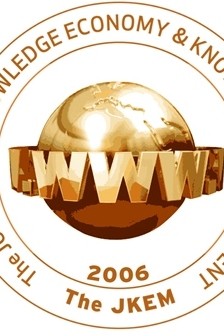ON THE RELATIONSHIP BETWEEN ORGANIZATIONAL SIZE AND FORMALIZATION OF KNOWLEDGE TRANSFER PROCESSES
Knowledge Transfer
ON THE RELATIONSHIP BETWEEN ORGANIZATIONAL SIZE AND FORMALIZATION OF KNOWLEDGE TRANSFER PROCESSES
Knowledge Transfer Organizational Size,
___
- Argote, L., Ingram, P., Levine, J.M., Moreland, R.L., 2000. Knowledge transfer in organizations: learning from the experience of others. Organizational Behavior and Human Decision Processes 82 (1), 1–8.
- Egbu, C.O., Hari, S., Renukappa, S.H., 2005. Knowledge management for sustainable competitiveness in small and medium surveying practices. Structural Survey 23 (1), 7–21.
- Evans, D.S., 1987. The relationship between firm growth, size and age: estimates for 100 manufacturing industries. Journal of Industrial Economics 35 (4), 567–581.
- Furnham, A., 2005. The psychology of behavior at work. The individual in the organization. Taylor and Francis, London, UK.
- Ghauri, P.N., Grİnhaug, K., 2005. Research methods in business studies. Prentice Hall, London, UK.
- Grant, R.M., 1996. Toward a knowledge-based theory of the firm. Strategic Management Journal 17, 109–122.
- Keil, T., Autio, E., George. G., 2008. Corporate venture capital, disembodied experimentation and capability development. Journal of Management Studies 45 (8), 1475–1505.
- Kets de Vries, M.F.R., Miller, D., 1986. Personality, culture, and organization. Academy of Management Review 11 (2), 266–279.
- Kogut, B., Zander, U., 2003. Knowledge of the firm and the evolutionary theory of the multinational corporation. Journal of International Business Studies 34, 516–529.
- March, J.G., 1991. Exploration and exploitation in organizational learning. Organization Science 2 (1), 71–87.
- Matlay, H., 2000. Organizational learning in small learning organizations: an empirical overview. Education and Training 42 (4/5), 202–210.
- McAdam, R., Reid, R., 2001. SME and large organization perceptions of knowledge management: comparisons and contrasts. Journal of Knowledge Management 5, 231–241.
- Minbaeva, D., 2007. Knowledge transfer in multinational corporations. Management International Review 47 (4), 567–593.
- Murray, S.R., Peyrefitte, J., 2007. Knowledge type and communication media choice in the knowledge transfer process. Journal of Managerial Issues 19 (1), 111–133.
- Nonaka, I., Takeuchi, H., 1995. The knowledge creating company. Oxford University Press, London, UK.
- Patton, M., 2002. Qualitative research: evaluation methods. Sage Publications, Boston, MA.
- Pleshko, L., Nickerson, I., 2007. Strategic comparisons of very large firms to smaller firms in a financial service industry. Academy of Strategy Management Journal 6, 105–116.
- Spence, L.J., 1999. Does size matter? The state of the art in small business ethics. Business Ethics: A European Review 8 (3), 163–174.
- Szulanski, G., 1996. Exploring internal stickiness: impediments to the transfer of best practice within the firm. Strategic Management Journal 17 (Special Winter Issue), 27–43.
- Teece, D., 2005. Technology and technology transfer: mansfieldian inspirations and subsequent development. Journal of Technology Transfer 30, 17–33.
- Thorpe, R., Holt, R., Macpherson, A., Pittaway, L, 2005. Using knowledge within small and medium-sized firms: a systematic review of the evidence. International Journal of Management Reviews 7 (4), 257–281.
- Wong, K.Y., Aspinwall, E., 2005. An empirical study of the important factors for knowledge-management adoption in the SME sector. Journal of Knowledge Management 9 (3), 64–82.
- Wong, K.Y., Aspinwall, E., 2004. Characterizing knowledge management in the small business environment. Journal of Knowledge Management 8 (3), 44–61.
- Wong, K.Y., 2005. Critical success factors for implementing knowledge management in small and medium enterprises. Industrial Management and Data Systems 105 (3/4), 261–279.
- Yin, R.K., 2003. Case research study: design and methods. Sage Publications, Boston, MA.
- Yayın Aralığı: Yılda 2 Sayı
- Başlangıç: 2006
- Yayıncı: İbrahim Güran YUMUŞAK
AN INNOVATION DRIVEN KNOWLEDGE MANAGEMENT FRAMEWORK FOR SME
YÖNETİM UYGULAMALARININ ULUSLARARASI TRANSFERİNDE RETORİK DİZİLERİNİN DEĞİŞMESİ
ON THE RELATIONSHIP BETWEEN ORGANIZATIONAL SIZE AND FORMALIZATION OF KNOWLEDGE TRANSFER PROCESSES
Martin SPRAGGON, Virginia BODOLICA
Abbas KHAKPOUR, Yrd. Doç. Dr.mohammad GHAHREMANI, Doç. Dr.mohammad Hassan PARDAKHTCHI
BİLGİYİ YÖNETMEK MÜMKÜN MÜ? ELEŞTİREL YÖNETİM ÇALIŞMALARI ÇERÇEVESİNDE BİLGİ YÖNETİM
Yrd. Doç. Dr.erkan ERDEMİR, Arş. Gör.dr.umut KOÇ
TÜRKİYE’DE EĞİTİM – İKTİSADİ BÜYÜME İLİŞKİSİ ÜZERİNE EKONOMETRİK BİR İNCELEME
Doç. Dr.Seyfettin ERDOĞAN, Arş. Gör.Durmuş Çağrı YILDIRIM
Strategic Initiatives: Fusion Of Knowledge, Economic, And Management Concepts
OVERCOMING CULTURAL OBSTACLES TO E- GOVERNMENT
YOUTH UNEMPLOYMENT PROBLEM IN ISLAMIC COUNTRIES
BEŞERİ SERMAYE VE İNSANİ GELİŞME İÇİN ERKEN ÇOCUKLUK EĞİTİMİNİN ÖNEMİ
